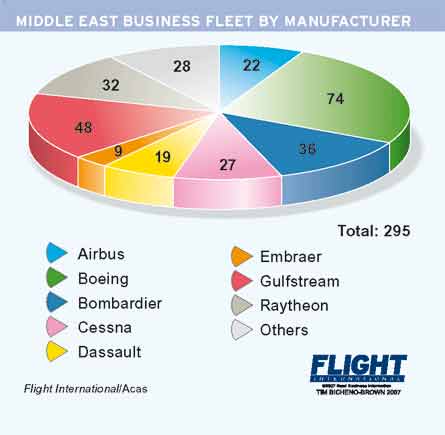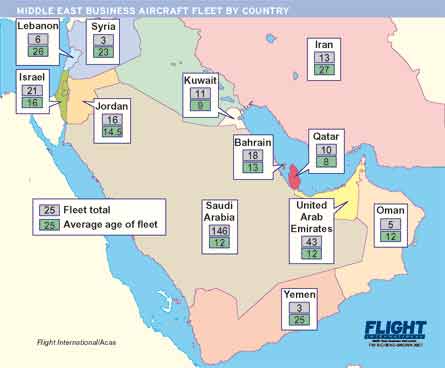No longer the preserve of the ultra-rich, small- and mid-size jets are changing the shape of business aviation in the Middle East
For years, any mention of Middle Eastern business aviation would conjure up an image of the super-rich with fleets of lavish widebody jets. But this is no longer a fair representation of business aviation in a region where, over the past decade, wealth has spread to a new breed of individuals and companies, boosted by booming economies. Consequently, aircraft are coming into their own as business tools in a locale where they once were synonymous with princely privilege.
According to Flight's data service Acas, as of 12 January the fleet in the Middle East totalled around 295 business aircraft. This does not include business aircraft in dedicated military service, of which there are around 68 according to Acas.
Notably, the tally does include 69 aircraft registered outside the region, but owned by Middle Eastern companies and individuals. The national aircraft registers of Aruba, Bermuda, Cayman, Switzerland and the USA, it appears, are particularly sought after by owners looking for favourable operating and tax benefits. Saudi Arabian owners account for the bulk of the aircraft on flags-of-convenience registers, totalling 62 including a government-owned Boeing Business Jet (BBJ).
In the past 12 months alone the region has welcomed several new arrivals, types including Bombardier Challenger 300 and Learjet 45XR, Cessna Citation Bravo, XLS and Sovereign, Dassault Falcon 2000EX, Embraer Legacy and Gulfstream G550.

Perhaps not surprisingly, Saudi Arabia is home to the largest fleet of business aircraft in the Middle East, claiming almost half the region's total with 146 aircraft. This country has provided the most fertile territory for airframe manufacturers for decades. It has the region's highest concentration of widebody airliners, including the first VIP-configured Airbus A340-600, delivered last year to Saad Group.
In recent years, airframer attention has widened to include other countries in the Middle East, notably Bahrain, Jordan and the United Arab Emirates (UAE), where wealthy entrepreneurs and individuals, corporations and charter companies are swelling the ranks of potential buyers. The UAE - which already boasts a fleet of 43 business aircraft - is arguably the largest of these emerging markets, followed by Israel with 21, Bahrain with 18 and Jordan 16.
While the infusion of new-generation business jets in the past decade has led to the withdrawal of older types, such as BAe 125s, Lockheed JetStars and Rockwell Sabreliners, out-of-production aircraft such as the Rockwell Turbo Commander and older Airbus, Boeing, Lockheed airliner types still account for more than 9% of the market.
The existence of these older types is creating a fertile replacement market that airframers are pursuing. According to Acas, the average age of business aircraft across the region is around 16 years. The oldest jets are in Iran, where the average age is 27 years. This is almost matched by the ageing fleets of Lebanon and Yemen, with an average age of 26 and 25 years respectively. In contrast, the youngest fleets can be found in Qatar and Kuwait with corresponding averages of eight and 10 years.
The Middle East is now open to updating its fleets with the latest models, says Boeing Business Jets president Steven Hill. Perhaps not surprisingly, Boeing dominates the Middle East inventory with an installed base of 74 aircraft, representing 20% of the region's fleet. Types range from corporate-configured widebody airliners such as the 747 (of which there are 15), 767 (four) and 777 (two) to the 737-based BBJ, with a fleet of 24 aircraft.
A quarter of all BBJ sales are made in the Middle East, where Boeing's line-up accounts for three-quarters of the VIP widebody-airliner fleet. "The Middle East is our largest market outside North America and is growing considerably," Hill says.
There is strong activity in the widebody replacement market, Hill says, notably in the Saudi Royal Flight. The Boeing 787-8/9 is "the mainstay of widebody activity this year", he says, and is being lined up as a replacement for the Airbus A330 and Lockheed L-1011 as well as Boeing's own 767. "Over half of the VIP 787 sales announced so far are in the Middle East," Hill says.
There is an ongoing requirement to replace the 737 family across the fleets of the region's royal families and those of private individuals, Hill says. There is also a market for additional new aircraft, particularly from customers "who are moving up from top-of-the-range Gulfstreams", he says, adding: "Once someone has had a large-cabin aircraft they tend not to go backwards."
Sophisticated market
Offering its Airbus Corporate Jetliner (ACJ) as a competitor to the BBJ, the European aircraft manufacturer says that the Middle East accounts for around 30% of sales, with more than a dozen of the aircraft in service in the region. VIP sales of widebody airliners are also gaining pace for Airbus as delivery of Saad's A340-600 illustrates, while a Middle Eastern customer is tipped to be the first private owner of a VIP-configured A380 airliner.

Airbuses are relative newcomers to the Middle Eastern VIP market compared with Gulfstreams, which remain the region's most widely owned dedicated business jets. The US airframer has held a strong position here for decades, partly due to the prestige of its brand, and is also well entrenched in the special missions market. Gulfstream claims nearly 50% of the mid-size and above market in the Middle East, but dominates the large-cabin, ultra-long-range market, with an installed base of 49 GV and G550-series aircraft. "This is a highly sophisticated market which represents on average around 5% of Gulfstream's total annual sales," says the company.
Gulfstream admits its does not have a similar share on the large-cabin market, dominated as it is by Bombardier and Dassault with their respective Challenger 604 and Falcon 2000. Bombardier has an installed fleet of 36 jets and Dassault 19.
As the demand for and uses of business jets have broadened, the region has also become a magnet for manufacturers of smaller aircraft.
Although Cessna delivered its first Citation business jet around 20 years ago, its aircraft have only found acceptance in the region since 2000. "In recent years, business aviation in the Middle East has evolved from a lifestyle accessory into an invaluable tool for business," says Saad Wallan, chief executive of Wallan Aviation, Cessna's sole representative in the Middle East.
"The Citation line is benefiting particularly from a growth in regional trade," says Wallan. The past two years have been particularly positive for Cessna, with nine deliveries in 2006 alone including a mid-size Sovereign, a super-light XLS and CJ2, CJ3 and Bravo light jets. The manufacturer has an installed fleet of 28 Citations representing 9% of the market, and sees more demand for smaller jets. "There is definitely a niche market for the entry-level Mustang from owner flyers and small businesses," Wallan says.
Focus on operating costs
The region's shift towards smaller cabin aircraft has also benefited Raytheon, which has an 11% share of the market with an installed base of 32 jets. Ted Farid, vice-president for international sales at the manufacturer, says the mid-size Hawker 800XP is the most popular of Raytheon's business jet line in the region. "It has good cabin size and range which will cover Dubai to Cairo with ease, and is a good performer in hot conditions," he says. The next most popular is the Beechcraft King Air 200 twin-turboprop.
There is more interest now in smaller business aircraft across the Middle East than ever before, Farid says. "While the region's royal families are still buying the largest jets, a new generation of private owners is emerging who are focused on typical issues such as acquisition price, depreciation and operating costs."
Source: Flight International























